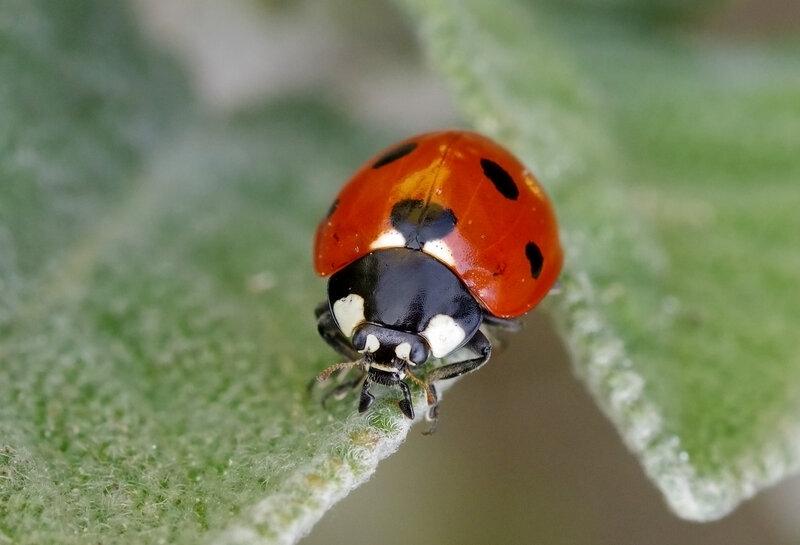CA Contractors #344056

One of the most powerful steps you can take when creating a sustainable landscape is the commitment to avoiding harmful pesticides and herbicides. These toxic chemicals are harmful to the air, water, and soil. At the same time, we understand your desire to have beautiful blooms and optimize vegetable garden yields.
To that end, we introduce you to 10 of the best insects to welcome and support in your garden. They pollinate, attack, and eat the larva, young, or adult forms of insects most likely to damage your flowers or vegetables. When you use pesticides, you’re just as likely to kill the good guys as you are to kill the bad guys, and that is bad for everyone.
Gardeners divide beneficial insects into three separate categories:
The more insects you have from each category, the less you’ll see harmful pests in the garden.
Once you learn to identify beneficial insects in your garden, or you learn where to purchase them (that’s right! Beneficial insects are a hot commodity in the gardening world…), you can design a garden landscape that attracts and supports a healthy population of these incredible creatures.
Ladybugs are a favorite due to their cheerful red “jackets” and the songs and rhymes created about them. In the garden, ladybugs are ferocious pests. Their larval form, black with orange markings, eats up to 40 aphids an hour. They’ll find your garden on your own, but you can give the population a boost by purchasing some at your local garden supply. These insects disperse once they’re released, so you are better off releasing ladybugs from down the street or in a neighbor’s garden to reap the best benefits.
Attract them with: zinnias, yarrow, Queen Anne’s lace, lemon balm, dill, bergamot, mint, parsley, goldenrod, thyme, cosmos
These graceful and delicate flying insects are as lovely as their name implies. In their adult form, green lacewings are pollinators. In their larval form, they are predators that eat soft-bodied pests such as caterpillars and slugs. They are nocturnal, so you may see them flying near outdoor lights.
Attract them with: coriander, fennel, cosmos, ornamental onion, yarrow, tansy, sunflowers, dill
Do you struggle to keep tomato hornhttps://bayarea-landscapers.com/vegetable-gardening-for-beginners/worms under control? What about those pesky cabbage moths that gobble up your cruciferous veggies? Parasitic wasps are the answer. Not surprisingly, they fall into the “parasitizer” category. They lay their eggs on tomato hornworms, and their babies eat up the worm once they hatch.
Attract them with: zinnias, yarrow, Queen Anne’s lace, alyssum, dill, fennel, thyme, and statice
The Praying Mantids is one of the most extraordinary insects to observe. They get their name due to their tell-tale posture - forelegs together as if in prayer. However, they could just as accurately be called “preying” mantids due to their voracious appetite for plant-eating moths, flies, and beetles. If praying mantis populations get too big, it’s worth picking them off and relocating them as they can consume helpful pollinators as well.
Attract them with: fennel, marigolds, yarrow, cosmos, dill
If you have a cutting garden or lots of colorful blooms, you’re probably familiar with the soldier beetle. They love to hang out on bright flowers, waiting for aphids or for moth and grasshopper larva to pass by.
Attract them with: marigolds, goldenrods, zinnias
Spiders are not insects; they are members of the arachnid family. They devote tremendous energy and time to building beautifully complex webs. The webs are dedicated wholly to capturing live insects, which is their only food source. Wolf spiders and jumping spiders are the best insect trappers, but any spider should be left in place or gently brushed off cut flowers or harvested veggie leaves, so they can continue working on your landscape’s behalf.
Attract them with: ground cover, perennial plants, undisturbed areas, rocky crevices, woodpiles
The ground beetle population is diverse, and all fall under the predatory category of beneficial insects. They aren’t picky, and their diet consists of various insects, including weevils, thrips, caterpillars, slugs, nematodes, and silverfish.
While most ground beetles are helpful, Japanese beetles are not. They are brilliant emerald green, and eradicating them protects leafy trees, grass, and other vegetation.
Attract them with: potted plants, rotting wood, flagstone paved areas, exposed dirt, perennial plants
Guess what category assassin bugs fall into? These predatory masters eat just about everything, and that has positives and negatives. If you have a diverse garden that attracts a wide variety of insects, assassin bugs are helpers. If there aren’t enough of the “bad guys” to feed assassin bugs, they’ll begin preying on beneficial insects, too.
Attract them with: fennel, dill, and coriander.
They may be small, but the tachinid fly is mighty when it comes to healthy pest control. Like the green lacewing, tachinid flies lay their eggs in a host, usually a soft-bodied larva or slug.
Attract them with: carrots, anise hyssop, lemon balm, dill, coriander, parsley, tansy, Queen Anne’s lace, clover
Hoverflies resemble miniature wasps, but they don’t have a stinger, so there’s no need to worry. They are pollinators as well as predators. Hoverflies eat large quantities of aphids, thrips, caterpillars, mealy bugs, scale, and beetles. They get their name because they hover as they pollinate, looking like tiny helicopters.
Attract them with: bergamot, yarrow, cosmos, mint, lemon balm, dill, goldenrod, zinnias, parsley
If you have kids at home, we recommend sharing this list with pictures and sending them out to identify which beneficial insects and arachnids already make their home in your garden.
Need help planning a diverse landscape that suits your location and makes a perfect landing pad for beneficial insects? Contact us here at Bay Area Landscapes.